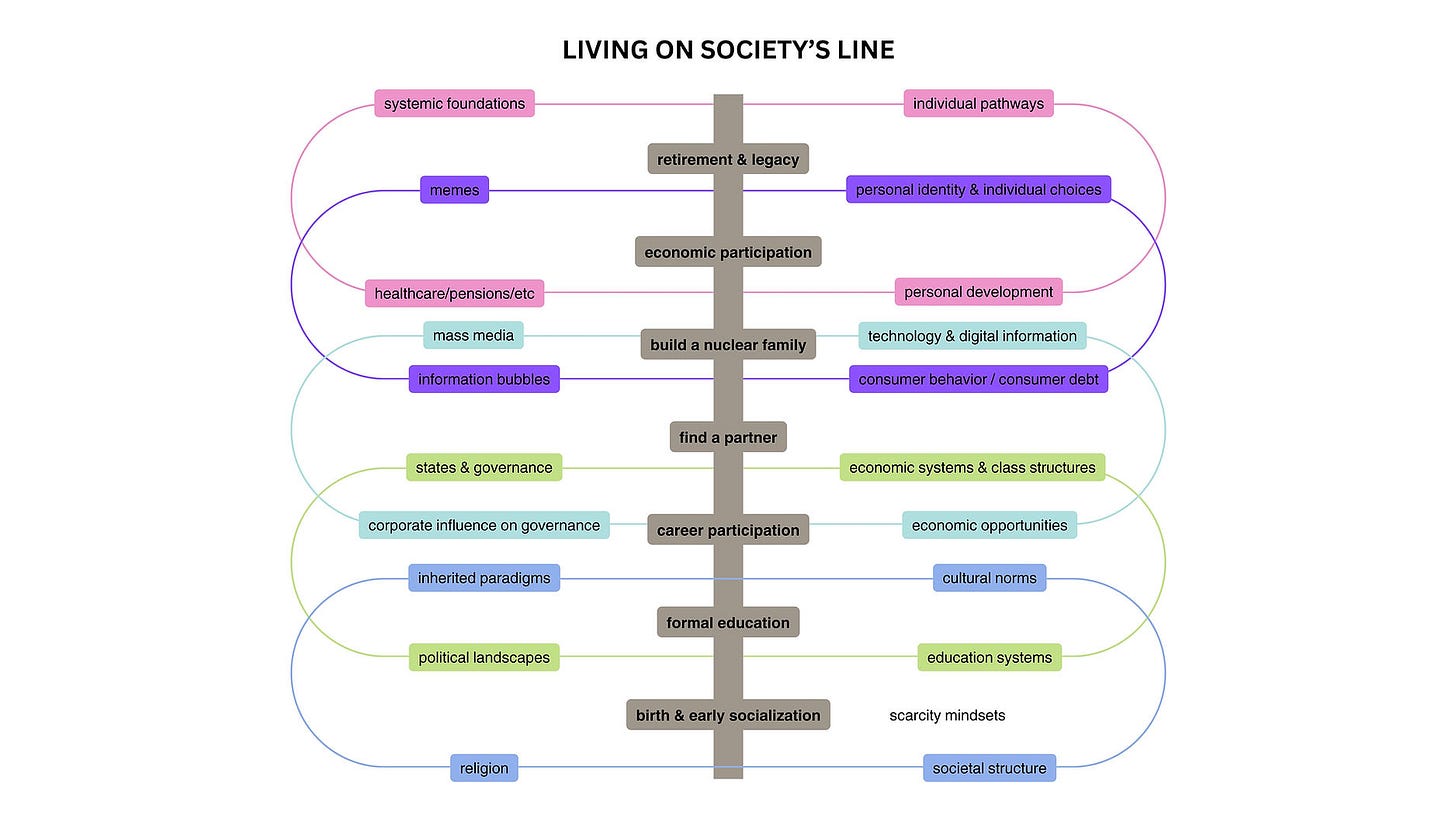"Everything is connected... no one thing can change by itself." - Paul Hawken
We often think of our lives as a series of discrete events. Go to work, eat lunch, call a friend, sleep. But what if I told you that's like looking at a forest and only seeing individual trees?
The world is more connected than we realize. Your lunch choice affects farmers halfway across the world. That call to your friend shapes both your moods, potentially altering the course of your days. Even your sleep patterns tie into global economic rhythms.
This interconnectedness isn't just an interesting fact—it's a powerful lens for understanding and improving our lives. It's called systems thinking, and once you start seeing the world this way, you can't unsee it.
I first stumbled onto systems thinking when I was trying to figure out why my attempts at self-improvement kept falling flat. I'd set a goal—say, to exercise more—but it never seemed to stick. Then I realized I was looking at exercise in isolation, instead of as part of the complex system of my life.
When I zoomed out, I saw how my sleep habits, work stress, and social life all intertwined with my ability to maintain an exercise routine. Changing one part meant adjusting the whole system. It was harder, but also more effective.
This essay is about how adopting a systems view can transform not just how you see the world, but how you operate within it. We'll look at:
What systems thinking actually is (minus the jargon)
How it's shown up throughout history and across cultures
The hidden systems we're all born into
Practical ways to apply systems thinking to your life
How this approach has concretely improved my own life
Fair warning: once you start seeing systems, you'll find them everywhere. It's a bit like putting on glasses for the first time. The world suddenly comes into focus, revealing both beauty and complexity you never noticed before.
So let's dive in. Not by breaking things apart, but by seeing how they fit together.
What is Systems Thinking?
Systems thinking is seeing the world as a set of interconnected... well, systems. Instead of looking at things in isolation, you look at how they interact.
Think of your body. You could study your heart by itself, but you'd miss a lot. Your heart works with your lungs, which work with your blood, which feeds your muscles, and so on. Change one part, and you affect the whole system.
The same idea applies to everything. Your social life, the economy, the environment—they're all systems made up of interconnected parts.
Here's a simple example: You decide to buy a coffee. Seems straightforward, right? But let's zoom out:
Your choice affects the coffee shop's sales, influencing their ordering and staffing.
It impacts your personal budget, maybe subtly shifting your other spending.
The coffee's production involved farmers, shippers, roasters—a whole economic chain.
Your caffeine intake might change your sleep, affecting tomorrow's productivity.
One small decision, rippling through multiple systems. That's systems thinking in action.
A Brief History of Connected Thinking
The idea that everything is connected isn't new. Ancient philosophers were onto it long before we had a fancy name for it.
Eastern philosophies like Taoism and Buddhism talk about the world as a flow of interconnected elements.
Indigenous cultures often see humans as part of nature, not separate from it.
Even in ancient Greece, Aristotle said, "The whole is greater than the sum of its parts."
These ideas laid the groundwork for modern systems thinking. But it really took off in the 20th century.
Scientists started realizing that breaking things into smaller and smaller parts wasn't always the best way to understand them. Sometimes, you need to step back and look at the big picture.
Biologists noticed that living things behave differently than you'd expect from just studying their parts. Economists saw that markets do weird things you can't predict by looking at individual buyers and sellers.
Computers gave us new tools to model complex systems. Suddenly, we could simulate things like climate patterns or traffic flow in ways we couldn't before.
Today, systems thinking isn't just for scientists. It's a tool anyone can use to understand the world better—and to navigate their own life more effectively.
The Systems We're Born Into
Here's something most people don't realize: We're all born into systems we didn't choose. These systems shape our lives in profound ways, often without us noticing.
Think about it:
Economic Systems: Whether you're born into capitalism, socialism, or something in between affects your opportunities from day one.
Cultural Norms: The shared beliefs and practices of your community shape everything from how you eat to how you view success.
Education Systems: The schools available to you influence not just what you learn, but how you think.
Family Structures: Whether you grow up in a nuclear family, an extended clan, or something else entirely shapes your view of relationships.
Technology Ecosystems: Born in Silicon Valley or rural Mongolia? Your relationship with tech will be very different.
Environmental Systems: The climate and landscape you grow up in affect your health, your hobbies, even your concept of beauty.
The list goes on. Political systems, healthcare, social hierarchies—all these are systems we inherit.
Here's the kicker: The less you understand these systems, the more they control you. It's like being a character in a story without realizing you're in a book. Once you see the page, you can start to write your own narrative.
Putting Systems Thinking to Work
So how do you actually use systems thinking in your life? It's not about becoming a hermit and contemplating the interconnectedness of all things. It's about making better decisions and understanding yourself more deeply.
Here are some practical steps:
Ask "And then what?": When you're making a decision, don't stop at the immediate outcome. Ask what might happen next, and then after that. It's like playing chess—the best players think several moves ahead.
Look for Feedback Loops: Some actions reinforce themselves. Exercise gives you more energy, which makes you want to exercise more. Debt can lead to more debt through interest. Spotting these loops helps you amplify the good ones and break the bad ones.
Find the Leverage Points: In any system, there are places where a small change can have a big effect. In your personal life, this might be a keystone habit that improves many areas at once. For me, it was fixing my sleep schedule. It improved my work, my mood, and my health.
Embrace Complexity: (But Don't Get Paralyzed) The world is complex. Accept it. But don't let that stop you from acting. Perfect information is impossible. Make the best decision you can with what you know, and be ready to adjust.
Practice Systems Mapping: Try drawing out the connections in a situation. It doesn't have to be fancy - just boxes and arrows on paper. Seeing these connections visually can reveal insights you might miss otherwise.
How Systems Thinking Changed My Life
This isn't just theory. Adopting a systems view has concretely improved my life in several ways:
Better Decision Making: I used to make decisions based mostly on immediate outcomes. Now I consider the wider ripple effects. It's led to choices that align better with my long-term goals.
Improved Relationships: Seeing relationships as systems of mutual influence has made me more empathetic and patient. I understand now that my actions affect others in complex ways, and vice versa.
More Effective Problem Solving: Instead of tackling problems in isolation, I look for root causes and connections. It often leads to solutions that address multiple issues at once.
Enhanced Creativity: Systems thinking has made me better at connecting disparate ideas. It's like having a new toolkit for creativity.
Greater Sense of Purpose: Understanding how my actions ripple out into the world has given me a stronger sense of responsibility and connection. It's oddly empowering to realize you're part of something bigger.
The Bigger Picture
Imagine a world where everyone thought this way. Where we considered the long-term consequences of our actions, understood our place in larger systems, and saw the connections between seemingly unrelated things.
We might approach problems differently. Instead of quick fixes, we'd look for sustainable solutions that address root causes. We'd see how social issues, economic policies, and environmental concerns are all intertwined.
Education might change, focusing more on interdisciplinary thinking and real-world problem solving. Businesses might prioritize long-term sustainability over short-term profits. Policy makers might craft more holistic, far-sighted policies.
It's a big vision. But it starts small—with each of us choosing to see the systems we're part of and acting accordingly.
Wrapping Up
Systems thinking isn't a magic bullet. The world is still complex, often frustratingly so. But it's a powerful tool for navigating that complexity.
Start small. The next time you're faced with a decision or a problem, try zooming out. Look for connections. Ask "And then what?" a few times. You might be surprised at what you discover.
Remember, you're not just a passive observer of the systems around you. You're an active participant. By understanding these systems better, you gain the power to influence them, to shape your path more intentionally.
It's a different way of seeing the world. And once you start, you can't unsee it. But that's a good thing. Because in a world that's more connected than ever, we need ways of thinking that embrace that connectedness.
So here's to seeing the forest and the trees—and all the connections in between.







